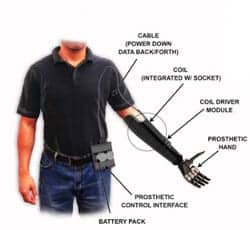Amputee sprinters using running prostheses, or blades, have no clear competitive advantage at the 400-meter distance compared to sprinters with biological legs and, in fact, appear to have a significant disadvantage at the start, according to University of Colorado Boulder research.
The study, published in Royal Society Open Science, provides a comprehensive set of data from elite runners with bilateral leg amputations, including the world’s fastest 400-meter sprinter, Blake Leeper. Leeper was ruled ineligible to compete in the Tokyo Olympics due to having an assumed advantage.
When comparing performance data from Leeper, South African “blade runner” Oscar Pistorius and up to six other bilateral amputee sprinters with those of the best non-amputee sprinters in the world across five performance metrics, the research found no advantage.
“A lot of assumptions have been made about running prostheses and performance with no data to support them. With this study, we show that the use of running prostheses provides no competitive advantage over 400 meters compared to biological legs.”
— senior author Alena Grabowski, associate professor of integrative physiology at CU Boulder
For the study, Leeper — who was born without legs — visited Grabowski’s Applied Biomechanics Lab for a series of tests in 2018. That summer, he had sprinted the 400-meter in 44.42 seconds, breaking the record of Pistorius, the first below-the-knee amputee to compete against able-bodied runners at the Olympic games.
Starting with Pistorius
After Pistorius’ history-making run in 2012, the International Association of Athletics Federations (now World Athletics) ruled that, going forward, athletes using “mechanical aids” must provide evidence that their blades do not give them a competitive edge.
Leeper enlisted Grabowski, an expert in running prostheses biomechanics who had collected similar data on Pistorius years earlier.
On the treadmill and track, researchers measured Leeper’s acceleration out of the starting blocks, maximum speed along straight-aways and around curves, velocity at aerobic capacity, and sprint endurance (all-out effort).
They took the top metrics from all available data from elite bilateral amputees and compared them to the top metrics from non-amputees.
“We found that no athlete with prosthetic legs has ever performed better than elite non-amputee athletes in lab-based experiments in any measure that relates to sprinting performance.”
— first author Owen Beck, a postdoctoral fellow at Emory University who flew to CU Boulder, where he got his PhD, to help conduct the study
Athletes using prostheses were 40% slower out of the starting blocks, had 19% slower velocity at aerobic capacity and were 1 to 3% slower around curves compared to non-amputees.
“To our knowledge, this is the first study to really address all the parts of the race and put it all together. Still, we found no advantage.”
— co-author Paolo Taboga, an assistant professor of kinesiology at California State University, Sacramento
The authors presented preliminary results to the Court of Arbitration for Sport in 2020, but the court ruled that Leeper could not participate in World Athletics-sanctioned events, including the Olympics, because his prostheses made him too tall. (In a previous study, published in the journal PLOS One, Grabowski and her colleagues found that height makes no difference when it comes to maximum sprinting speed.)
The researchers said they hope the publication of the new study in a peer-reviewed-journal will not only nudge World Athletics to take a closer look at its policies, but also help the rest of the world form an informed opinion. They encourage other researchers to publish more data.
“I hope this will get people to really question rules being put into place that keep athletes with disabilities from competing even when they have shown with science that they can compete fairly,” Grabowski says.
[Source(s): University of Colorado at Boulder, Science Daily]





